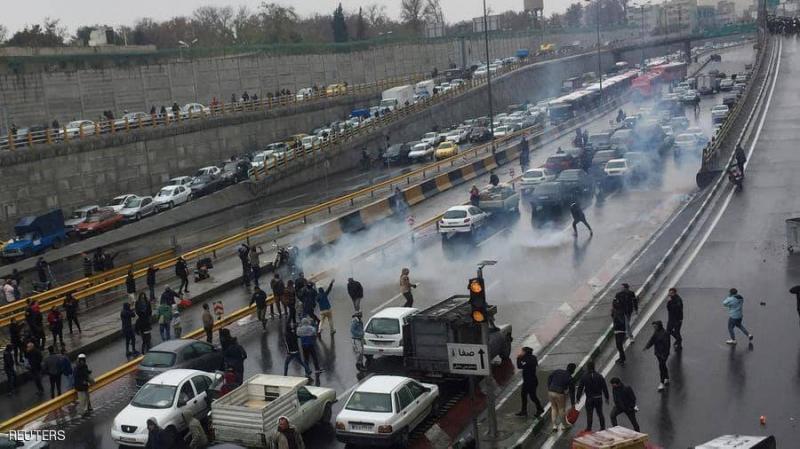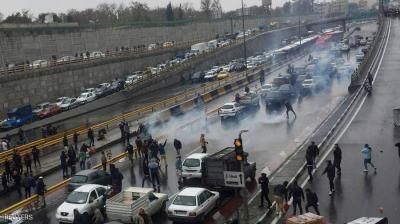On Sunday, the Iranian police announced the arrest of 10 members of the leaders of the "White Uprising," amid escalating official concerns over the possibility of protests marking the second anniversary of the fuel protests that resulted in dozens of deaths and hundreds of detentions. The "White Uprising" movement is a recently emerged opposition group on social media, led by an individual named "Dr. Sayyan," which calls for protests against the regime on the second anniversary of the fuel protests from Revolution Square in the capital, Tehran. The group's name first appeared in September when the Iranian intelligence ministry announced the arrest of one of its leaders, named "Mohammad Hossein Bour."
As the second anniversary of the fuel protests approaches, which falls in mid-November, security agencies have intensified their arrest campaigns targeting those they label as the leaders of the "White Uprising." On Friday, the "Imam Hassan Mujtaba Brigade" in Alborz province, west of the capital, announced that they had arrested leaders of the White Uprising during a special operation, without specifying their number or identities. They stated that the individuals "were planning to disrupt the security and stability of the province and other areas of the country through demolitions," confirming that "the movements of the splinter groups are under complete surveillance by the Revolutionary Guards."
On Sunday, Iranian Deputy Security Forces Commander Mohammad Akhlaghi reported that "10 people associated with the White Uprising have been arrested, and they are managers active in the cyberspace." He explained that "since the beginning of November, we have witnessed numerous calls on social media by a group called the White Uprising, urging people to gather in the streets and main squares of Iranian cities." He noted that "the group's primary objectives are to disrupt the regime and security by calling for protests in city squares and streets, and writing slogans on buildings and walls against the regime."
Concerns were expressed by officials last Thursday when Iranian Interior Minister Ahmad Vahidi stated that enemies of Iran (unnamed) are planning protests in November similar to those in 2019 and that the shutdown of fuel stations in Iran is a precursor to demonstrations. Vahidi clarified that the recent cyberattack on fuel stations and public anxiety over the gasoline issue stem from "enemy scheming." His comments came alongside disruptions experienced at gasoline stations across Iran due to a software malfunction affecting the subsidized card payment system, amidst widespread discontent within the country.
Protests erupted in November 2019 at nearly 700 locations across Iran after the authorities raised fuel prices without prior notice, lasting for ten days during which 7,113 individuals were arrested. Iranian officials acknowledged that the authorities were responsible for the deaths of 80% of the victims during the November protests. The Interior Ministry at the time stated that the death toll from the November protests triggered by fuel price increases was less than 225 individuals, but non-governmental estimates indicated that the actual number was much higher.
Iranian political analyst Ahmad Hashemi expressed that a "hunger uprising" is certainly expected soon due to the deteriorating economic conditions in the country, especially if the nuclear negotiations do not yield results and international sanctions are not lifted. Hashemi, a former official in the Iranian foreign ministry, told "Sky News Arabia" that he does not expect a strong uprising to coincide with the anniversary of the fuel protests, affirming that the Iranian regime will preemptively seek to arrest organizers and potential leaders of any protests and suppress them through repression. He explained that any uprising and genuine change will come from non-Persian ethnic groups, particularly Azerbaijani Turks and Ahwazi Arabs, asserting that they are the only opposition forces capable of mobilizing and standing against the regime in Iran, and "I expect to see more organized protests in the Arab and Azerbaijani regions of Iran in the near future." He believed that Persians, who make up about half of Iran's population, are less enthusiastic about taking to the streets and protesting against the regime.
In July, the city of Ahvaz in southwestern Iran witnessed widespread demonstrations called "Water Protests," resulting in deaths and injuries as residents demanded water provision and the resignation of local officials due to mismanagement of the crisis affecting the region, home to nearly 5 million people. The water scarcity in Iran is attributed to various weather-related factors, including a sharp decline in rainfall, which has reduced levels by more than 40% compared to last year in recent months.




